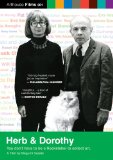| Reviews & Columns |
|
Reviews DVD TV on DVD Blu-ray 4K UHD International DVDs In Theaters Reviews by Studio Video Games Features Collector Series DVDs Easter Egg Database Interviews DVD Talk Radio Feature Articles Columns Anime Talk DVD Savant Horror DVDs The M.O.D. Squad Art House HD Talk Silent DVD
|
DVD Talk Forum |
|
|
| Resources |
|
DVD Price Search Customer Service #'s RCE Info Links |
|
Columns
|
|
|
Herb & Dorothy
Fascinating. Arthouse Films has released Herb & Dorothy, a 2008 documentary by director Megumi Sasaki that shines a light on the extraordinary Vogels, the "mascots of the art world" who, over a forty year period of living and breathing art in New York City, managed to amass one of the most complete, influential collections of minimalist and conceptual art in the world...and all on their combined librarian and postal worker salaries. You don't have to know a thing about the artwork discussed here - you don't even have to like it, frankly - to enjoy this utterly bizarre and quite moving story of two extraordinary "ordinary" people who made their own lives, a work of art.
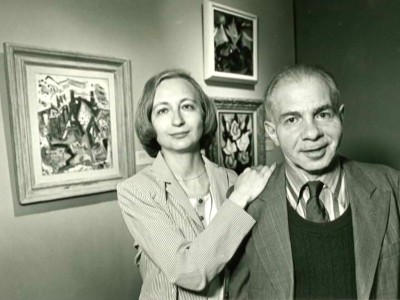
In 1959 New York, self-taught art historian Herb Vogel, who paid the bills as a postal sorter on the midnight shift, met Dorothy, a reference librarian for the Brooklyn Public Library, at a dance social. Both had tried their hands at becoming artists, but found their talents lacking (by their own aesthetic standards). They dated for a year, married, and then embarked on an extraordinary odyssey of collecting artwork in that single-minded, greedy way all obsessed collectors collect, but with a big difference: they didn't do it for the money. Their obsession was to possess beautiful objects, and to immerse themselves in an art world they probably would never have known had they stuck to their own artistic endeavors. To do this on their relatively meager salaries (if you're talking in the context of eventually amassing a literally priceless collection), they maintained a few strict rules: the piece had to be "affordable," and it had to fit within the confines of their cramped apartment. Dorothy's salary went towards living expenses, which were manageable since they lived (and still do) in a small, one-bedroom rent-controlled apartment in Manhattan, while Herb's salary went towards acquiring art.
By 1960, the Abstract-Expressionist movement was giving way to Pop Art as the main driver of the New York City art scene, with both disciplines proving far too expensive propositions for the frugal, capital-challenged collectors. So, the Vogels became attracted to the still-nascent Minimalist and Conceptual movements, where works went cheap. Acquiring their first piece - an untitled work by John Chamberlain in 1962 - the Vogels became obsessed in their pursuit of affordable, portable art (another rule was the piece had to be of a size where it could be transported by either subway or taxi). Apparently any spare time, workday or day-off, was used to prowl around galleries, attend exhibitions, and meetings with the artists, where the Vogels becoming friends with the budding artists. The Vogels immediately made a name for themselves in the small, enclosed Minimalist and Conceptual art world because quite simply, they were one of the few buyers of these artists' works at that time, and more importantly, as artist Chuck Close states in the film, they "came with cash in hand," a welcome sight for the then-struggling artists (he also admits the Vogels were picking up pieces for $100 when they first started - pieces that now would fetch hundreds of thousands of dollars). And through this dedication to art for art's sake, through this extraordinary concentration on their one true passion, they suddenly found themselves at the center of those two emerging art movements, with many of the artists they first help support, going on to become very influential - and very wealthy - icons of the New York City art world.
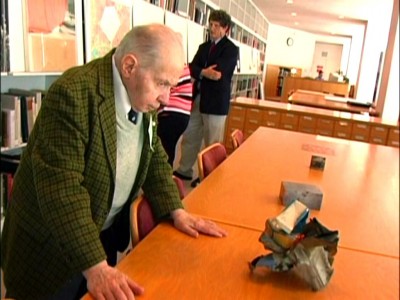

Deemed "the mascots of the art world," the Vogels continued to aggressively collect works through the 60s, 70s, and 80s, filling their tiny apartment literally to the ceiling with crates and crates of work, until a legend of sorts began to circulate among the world's cultured elites about this mysterious "Vogel collection" maintained by those two most unusual collectors. Herb and Dorothy soon became famous themselves (cover stories for big magazines and newspapers; interviews for TV like 60 Minutes; inclusion in text books about important U.S. collectors), all the while still maintaining their dual identities as thoroughly "ordinary" New Yorkers who worked at the post office and library. The elite of the art world, not just in New York but all over the world, vied to visit the small, cramped, unremarkable Vogel apartment to view the collection, while high society embraced these patrons of the arts as their own. Where they differed significantly, though, from these wealthy artists and their patrons, was their own view of their collection, and what it meant to them both monetarily and aesthetically. Making a vow to never sell one single piece they had purchased, the Vogels always considered each new purchase of an art work as another piece in the puzzle of their collection as a whole. The eventually monetary worth of the piece was of absolutely no importance to them (they state several times in the doc that they obsessively collected many artists who never became famous, also), only the beauty of the object itself. They did not collect to eventually "make a killing." They collected to enrich their own lives, with what they found beautiful.
Countless museums made bids for the Vogel collection over the years, but they were always rebuffed. Eventually, as the couple grew older and found it more difficult to collect, and after realizing that there simply was no more room in their apartment for more art, they offered the entire collection - without remuneration - to the National Gallery in Washington, D.C.. Staggered by not only the importance but the size of the collection (it took five jumbo-sized semi-trailers to empty the tiny apartment), the National Gallery eventually accepted over a thousand pieces of the four thousand-plus works the Vogels collected, giving the Vogels in lieu of outright payment a small annuity to ease their always-tight finances (the former curator of the Gallery states somewhat sheepishly that the collection is "priceless," meaning they would have had to pay anyone else many millions of dollars to even get their hands on a small piece of it). Of course, being the obsessed collectors they were, the Vogels immediately took that annuity, and collected more art. The remaining pieces in the collection, over 2,500, will be donated to a museum in each of the fifty states (fifty pieces per museum), and again, no money will change hands. The Vogels remain in that same, spartan apartment, to this day.
Herb & Dorothy is a difficult documentary to evaluate because its central story is so compelling, you tend to ignore the fact that the film itself is sometimes wanting. Having studied art in college before moving into "film studies" (hey, that was their term for it, not mine), I was already familiar with the various art movements that were discussed here in the doc (just for the record, among the movements discussed here, I prefer Pop Art, while some Minimalist art I find visually interesting. Conceptual art, though, such as Richard Tuttle's little piece of rope nailed to the Vogel's apartment wall, is a total intellectual scam in my book). But if you don't know anything about Minimalist or Conceptual art, it won't hamper your enjoyment of the Vogels' story (I watched the doc with someone who didn't know the first thing about any of this art, and they enjoyed it). And I specifically write "Vogels' story" because regardless of the film's drawbacks, their bio is so fascinating it can't help but make Herb & Dorothy worth viewing.
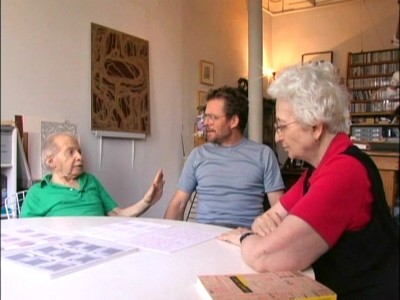
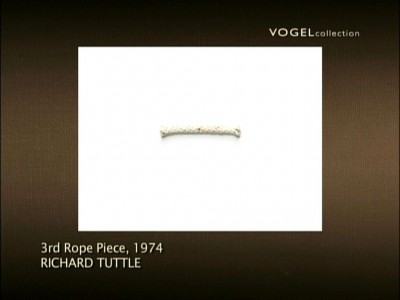
Just from a visual standpoint, Herb & Dorothy is remarkably static and compositionally dull - a shame considering the subject matter at hand (scenes that would seem obvious tributes to the very art that Herb and Dorothy loved, such as Herb finding himself in front of a multitude of blue fish tanks, looking to buy a fish, are either poorly shot or ignored outright). My main problem with Herb & Dorothy, though, is that the director, Megumi Sasaki, seems far too..."respectful" (for lack of a better word) of the aging collectors, to give a truly rounded portrait of their life's work. Perhaps because of their age, or perhaps because of the gravitas these world-famous collectors exude (even though they come off as thoroughly ordinary in behavior as you or I), the director doesn't intrude in any way on the Vogels' own depiction of their life. It's a marvelous story they tell, of passion for art and an almost impossible, herculean effort to amass art literally "for art's sake." At times, it almost seems like a fairy tale: two ordinary people somehow come together at the very nexus of the changing New York art scene in 1960, and through meager funds, begin to collect, at the ground floor, almost every single soon-to-be major Conceptual and Minimalist artist of the 20th century. And indeed, that "fairy tale" aspect of the film filters down into a portrait that refuses to ask a lot of questions I had about the Vogels and their process of collecting. It may sound trivial, or prurient, but I wanted some hard facts on what the Vogels were making in terms of salaries over the years, what they were paying for pieces over the years, and how the prices changed as the artists - and indeed the Vogels - became more famous. I think that information is central to understanding exactly how the Vogels were able to do what they did. It isn't enough for the film to say, "Isn't it amazing what the Vogels did? It's magical!" Yes, it is amazing, and yes, there is something altogether fantastical in how the Vogels single-mindedly turned major aspects of their lives into a pursuit for this artwork, a remarkable aesthetic exercise made 100% "authentic" by the simple fact that they never made any real money off the collection, when they could have become fabulously wealthy.
But it's not enough to just have the artists say how "cute" the Vogels were, and leave it at that. Surely, there were bumps in the road for the Vogels, at least financially (the film makes one vague reference to the Vogels' practice of "paying on time" for pieces, and that some of the more famous artists discounted their prices for them - but again, no real numbers). And what about any spiritual speedbumps for the rabid collectors? Surely there had to be one moment in their lives where they said, "What the hell are we doing here? Why the hell are we doing this?" as their walls and furniture became obscured by boxes and boxes and stacks of artwork? Didn't they ever experience some doubt about the direction of their lives so narrowly focused on one activity: the pursuit of collecting this rather rigorous, unforgiving art? I can't tell you, because the filmmaker apparently didn't ask them, either out of deference to their position or age. Listening to the roll call of world-famous artists discuss Herb and Dorothy in reverential terms, I didn't doubt their sincerity for a moment...but surely they had other feelings about the Vogels' process, or their own dealings with the collectors, that go beyond hagiography? It's not that I was looking for "dirt" in Herb & Dorothy, but depth, particularly when this deceptively simple story simply can't be that simple. Forget the major plot hole about money for a second. Forget also the film's refusal to acknowledge that people have complex feelings about everyone, even their best friends (so surely the artists involved here have more to say about Herb and Dorothy than, "They're terrific."). What about Herb's and Dorothy's own aesthetic process of selection? How did Herb Vogel (who seems to be the main driving influence behind the collection's selection) tune into something no one else seemed to have deciphered that early on? The film's answer comes down to letting Herb state the equivalent of that hoary old cliché, "I may not know art, but I know what I like." If that's all Herb wanted to say (or was asked to say) for the film, fine. But how about some analysis by others familiar with that time and place? How about some context as to how a guy like Herb Vogel did what he did? I felt good when I watched Herb & Dorothy, but I wound up with more far more questions than answers when it was finished.
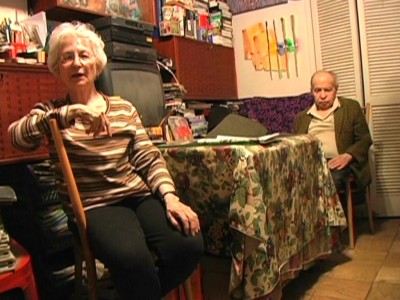
The DVD:
The Video:
The full-screen, 1.33:1 video transfer of Herb & Dorothy (which was shot on video), is adequate, with the expected look for this kind of footage (minimal video noise, adequate but not spectacular color, sharp picture, no compression issues to speak of). A very ordinary-looking doc, which is a shame considering some of the pieces on display.
The Audio:
The Dolby Digital English 2.0 stereo sound mix is crisp and clean, mixing the dialogue and the light, airy musical cues quite well. Subtitles and close-captions are not available.
The Extras:
There are seventeen minutes of deleted scenes included as bonuses here, including some longer sequences that were subsequently cut down for the feature. They're interesting additions to the film. Additional footage is also included covering Herb & Dorothy's festival appearances (which featured some Q & As with the Vogels), the New York City premiere of the film, while the original theatrical and PBS trailers for Herb & Dorothy are included, as well.
Final Thoughts:
The central biography of the Vogels is so strong that it doesn't matter in the end that Herb & Dorothy as a doc leaves a lot of questions unanswered. Theirs is an amazing story of passion and almost fanatical dedication to the pursuit of beauty and art, as they saw them, and one can't help but be moved by their relationship to these works of art, and to each other. I just wish the documentary had pushed a little harder to explore the fascinating undercurrents that are only suggested here in the Vogels' aesthetic journey. I recommend Herb & Dorothy.
Paul Mavis is an internationally published film and television historian, a member of the Online Film Critics Society, and the author of The Espionage Filmography.


|
| Popular Reviews |
| Sponsored Links |
|
|
| Sponsored Links |
|
|
| Release List | Reviews | Shop | Newsletter | Forum | DVD Giveaways | Blu-Ray | Advertise |
|
Copyright 2024 DVDTalk.com All Rights Reserved. Legal Info, Privacy Policy, Terms of Use,
Manage Preferences,
Your Privacy Choices | |||||||









